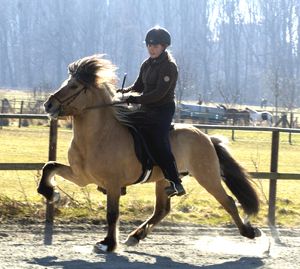|
American Walking Pony
The American Walking Pony is a modern American breed of gaited riding pony. It was created by crossbreeding of the Tennessee Walking Horse and the Welsh Pony. Originally developed in Georgia, the breed was established in 1968 after several years of selective breeding. Joan Hudson Brown is credited as the founder of the breed and was the first executive secretary of the breed registry. The original breeding goal was to combine the smooth gait of the Tennessee Walker with the small size and refinement of the Welsh pony. Any combination of the two breeds is acceptable for the registry. Foundation stock for the breed included BT Golden Splendor, the first stallion recorded with the registry, and the mare Browntree's Flicka, who was given registration number 1. The desired ambling gaits of the breed are smooth, called the Pleasure Walk and the Merry Walk. Ponies are also able to trot and canter, and have been exhibited in five-gaited competition. The gaitedness ability is heredi ... [...More Info...] [...Related Items...] OR: [Wikipedia] [Google] [Baidu] |
Horse Breed
A horse breed is a selectively bred population of domesticated horses, often with pedigrees recorded in a breed registry. However, the term is sometimes used in a broader sense to define landrace animals of a common phenotype located within a limited geographic region, or even feral "breeds" that are naturally selected. Depending on definition, hundreds of "breeds" exist today, developed for many different uses. Horse breeds are loosely divided into three categories based on general temperament: spirited "hot bloods" with speed and endurance; "cold bloods," such as draft horses and some ponies, suitable for slow, heavy work; and " warmbloods," developed from crosses between hot bloods and cold bloods, often focusing on creating breeds for specific riding purposes, particularly in Europe. Horse breeds are groups of horses with distinctive characteristics that are transmitted consistently to their offspring, such as conformation, color, performance ability, or disposition. ... [...More Info...] [...Related Items...] OR: [Wikipedia] [Google] [Baidu] |
Stallion
A stallion is a male horse that has not been gelded (castrated). Stallions follow the conformation and phenotype of their breed, but within that standard, the presence of hormones such as testosterone may give stallions a thicker, "cresty" neck, as well as a somewhat more muscular physique as compared to female horses, known as ''mares'', and castrated males, called ''geldings''. Temperament varies widely based on genetics, and training, but because of their instincts as herd animals, they may be prone to aggressive behavior, particularly toward other stallions, and thus require careful management by knowledgeable handlers. However, with proper training and management, stallions are effective equine athletes at the highest levels of many disciplines, including horse racing, horse shows, and international Olympic competition. "Stallion" is also used to refer to males of other equids, including zebras and donkeys. Herd behavior Contrary to popular myths, many stallions do no ... [...More Info...] [...Related Items...] OR: [Wikipedia] [Google] [Baidu] |
Show Jumping
Show jumping is a part of a group of English riding equestrian events that also includes dressage, eventing, hunters, and equitation. Jumping classes are commonly seen at horse shows throughout the world, including the Olympics. Sometimes shows are limited exclusively to jumpers. Sometimes jumper classes are offered in conjunction with other English-style events. Sometimes, show jumping is but one division of a very large, all-breed competition that includes a very wide variety of disciplines. Jumping classes may be governed by various national horse show sanctioning organizations, such as the United States Equestrian Federation or the British Showjumping Association. International competitions are governed by the rules of the International Federation for Equestrian Sports. Hunters or jumpers Show jumping events have hunter classes, jumper classes and hunt seat equitation classes. Hunters are judged subjectively on the degree to which they meet an ideal standard of man ... [...More Info...] [...Related Items...] OR: [Wikipedia] [Google] [Baidu] |
Pleasure Driving
Pleasure driving is a horse show class seen in the United States, which features light breeds of horses and ponies hitched to a two or four-wheeled show cart A cart or dray (Australia and New Zealand) is a vehicle designed for transport, using two wheels and normally pulled by one or a pair of draught animals. A handcart is pulled or pushed by one or more people. It is different from the flatbed tr .... Horses are driven at a walk and two speeds of trot, generally designated as a working or regular trot and an extended "strong" trot. Many horse breeds compete in Pleasure driving. Most classes are judged on the horse's manners, performance, quality and conformation. See also * Horse harness * Fine harness References Equestrianism Sources=http://www.australiancarriagedrivingsocietyvic.org.au/ {{equestrian-stub ... [...More Info...] [...Related Items...] OR: [Wikipedia] [Google] [Baidu] |
Fine Harness
Fine harness is a type of driving competition seen at horse shows, that feature light, refined horses with high action. Popular breeds in this event include the American Saddlebred, Morgan, Arabian The Arabian Peninsula, (; ar, شِبْهُ الْجَزِيرَةِ الْعَرَبِيَّة, , "Arabian Peninsula" or , , "Island of the Arabs") or Arabia, is a peninsula of Western Asia, situated northeast of Africa on the Arabian Plate. ..., Dutch Harness Horse, and Hackney (horse). Some breeds of pony are also shown in the fine harness style. These include the Hackney Pony, Welsh pony, and the American-type Shetland Pony. The horse harness, harness used is a light, breastplate type without a horse collar. The cart used is generally a light, four-wheeled design. Drivers wear formal attire. [...More Info...] [...Related Items...] OR: [Wikipedia] [Google] [Baidu] |
Roan Allen
Roan Allen (1904–1930) was one of the founding sires of the Tennessee Walking Horse. It is believed that all Tennessee Walking Horses alive today trace back to him. Life Roan Allen was born May 23, 1904, on the farm of James Brantley in Coffee County, Tennessee. He was sired by Black Allan, the stallion who would later be given the designation Allan F-1, and out of the mare Gertrude. Roan Allen was a red roan stallion with a blaze, front socks, and high hind stockings. When he matured, he stood and had a long flaxen mane and tail. He was noted for his good conformation. Brantley observed him performing a true running walk within a few hours of his birth. When Roan Allen was three years old, he was put in training with Charlie Ashley of Manchester, Tennessee. Ashley trained Roan Allen to perform seven distinct gaits on command, including the running walk, flat walk, fox trot, true trot and rack. When Roan Allen was fully trained, he was competed successfully in Walking Hor ... [...More Info...] [...Related Items...] OR: [Wikipedia] [Google] [Baidu] |
Five-gaited
Five-gaited horses are notable for their ability to perform five distinct horse gaits instead of simply the three gaits, walk, trot and canter or gallop common to most horses. Individual animals with this ability are often seen in the American Saddlebred horse breed, though the Icelandic horse also has five-gaited individuals, though with a different set of gaits than the Saddlebred. The ability to perform an ambling gait or to pace appears to be due to a specific genetic mutation. Some horses are able to both trot and perform an ambling gait, but many can only do one or the other, thus five-gaited ability is not particularly common in the horse world. In the American Saddlebred and related breeds, the five gaits performed are the walk, trot, canter, and two ambling gaits: the rack, a fast, lateral, four-beat gait that is synchronous— "each foot meets the ground at equal, separate intervals"; and a "slow gait", a slower, smooth collected four-beat gait that is asynchronous � ... [...More Info...] [...Related Items...] OR: [Wikipedia] [Google] [Baidu] |
Canter
The canter and gallop are variations on the fastest gait that can be performed by a horse or other equine. The canter is a controlled three-beat gait, while the gallop is a faster, four-beat variation of the same gait. It is a natural gait possessed by all horses, faster than most horses' trot, or ambling gaits. The gallop is the fastest gait of the horse, averaging about . The speed of the canter varies between depending on the length of the horse's stride. A variation of the canter, seen in western riding, is called a lope, and is generally quite slow, no more than . Etymology Since the earliest dictionaries there has been a commonly agreed suggestion that the origin of the word "canter" comes from the English city of Canterbury, a place of pilgrimage in the Middle Ages, as referred to in '' The Canterbury Tales'', where the comfortable speed for a pilgrim travelling some distance on horseback was above that of a trot but below that of a gallop. However a lack of com ... [...More Info...] [...Related Items...] OR: [Wikipedia] [Google] [Baidu] |
Trot
The trot is a ten-beat diagonal horse gait where the diagonal pairs of legs move forward at the same time with a moment of suspension between each beat. It has a wide variation in possible speeds, but averages about . A very slow trot is sometimes referred to as a jog. An extremely fast trot has no special name, but in harness racing, the trot of a Standardbred is faster than the gallop of the average non-racehorse, and has been clocked at over . On June 29, 2014, at Pocono Downs in Pennsylvania the Swedish standardbred Sebastian K trotted a mile in 1 minute, 49 seconds (quarters were passed at 26:2, 55:3 and 1,21:4). This is equivalent to a 1000-pace in 1.07,7 or 53.14 kilometers per hour or 33 miles per hour. From the standpoint of the balance of the horse, the trot is a very stable gait and does not require the horse to make major balancing motions with its head and neck.Harris, Susan E. ''Horse Gaits, Balance and Movement'' New York: Howell Book House 1993 pp. 35–37 D ... [...More Info...] [...Related Items...] OR: [Wikipedia] [Google] [Baidu] |
Mare
A mare is an adult female horse or other equine. In most cases, a mare is a female horse over the age of three, and a filly is a female horse three and younger. In Thoroughbred horse racing, a mare is defined as a female horse more than four years old. The word can also be used for other female equine animals, particularly mules and zebras, but a female donkey is usually called a "jenny". A broodmare is a mare used for breeding. A horse's female parent is known as its dam. Reproductive cycle Mares carry their young (called foals) for approximately 11 months from conception to birth. (Average range 320–370 days.)Ensminger, M. E. ''Horses and Horsemanship: Animal Agriculture Series.'' Sixth Edition. Interstate Publishers, 1990. p. 156 Usually just one young is born; twins are rare. When a domesticated mare foals, she nurses the foal for at least four to six months before it is weaned, though mares in the wild may allow a foal to nurse for up to a year. The estro ... [...More Info...] [...Related Items...] OR: [Wikipedia] [Google] [Baidu] |
Foundation Stock
Foundation bloodstock or foundation stock refers to animals that are the progenitors, or foundation, of a breed or of a given bloodline within such. Many modern breeds can be traced to specific, named foundation animals, but a group of animals may be referred to collectively as foundation bloodstock when one distinct population (including both landrace breeds or a group of animals linked to a deliberate and specific selective breeding program) provides part of the underlying genetic base for a new distinct population. Terminology The terms for foundation ancestors differ by sex, most commonly "foundation sire" for the father and "foundation dam" for the mother. Depending upon the species in question, more specialized terms may be used, such as ''foundation mare'' for female horses, ''foundation queen'' for female cats, or ''foundation bitch'' for female dogs. The offspring of genetically dissimilar parents or stock, whether of different species or different breeds are techni ... [...More Info...] [...Related Items...] OR: [Wikipedia] [Google] [Baidu] |
Gaited
An ambling gait or amble is any of several four-beat intermediate horse gaits, all of which are faster than a walk but usually slower than a canter and always slower than a gallop. Horses that amble are sometimes referred to as " gaited", particularly in the United States. Ambling gaits are smoother for a rider than either the two-beat trot or pace and most can be sustained for relatively long periods, making them particularly desirable for trail riding and other tasks where a rider must spend long periods in the saddle. Historically, horses able to amble were highly desired for riding long distances on poor roads. Once roads improved and carriage travel became popular, their use declined in Europe but continued in popularity in the Americas, particularly in areas where plantation agriculture was practiced and the inspection of fields and crops necessitated long daily rides. The ability to perform an ambling gait is usually an inherited trait. In 2012, a DNA study found tha ... [...More Info...] [...Related Items...] OR: [Wikipedia] [Google] [Baidu] |
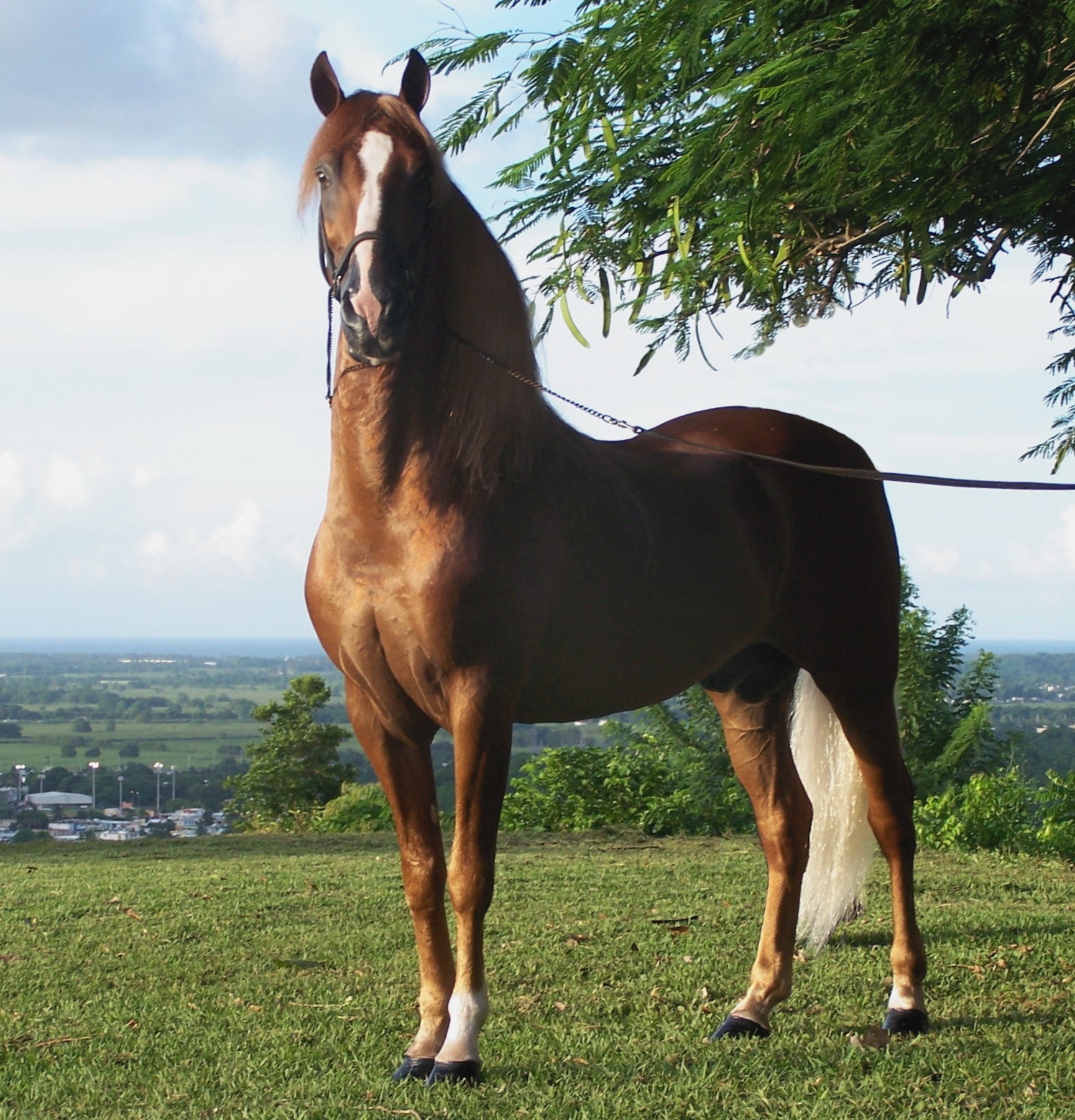
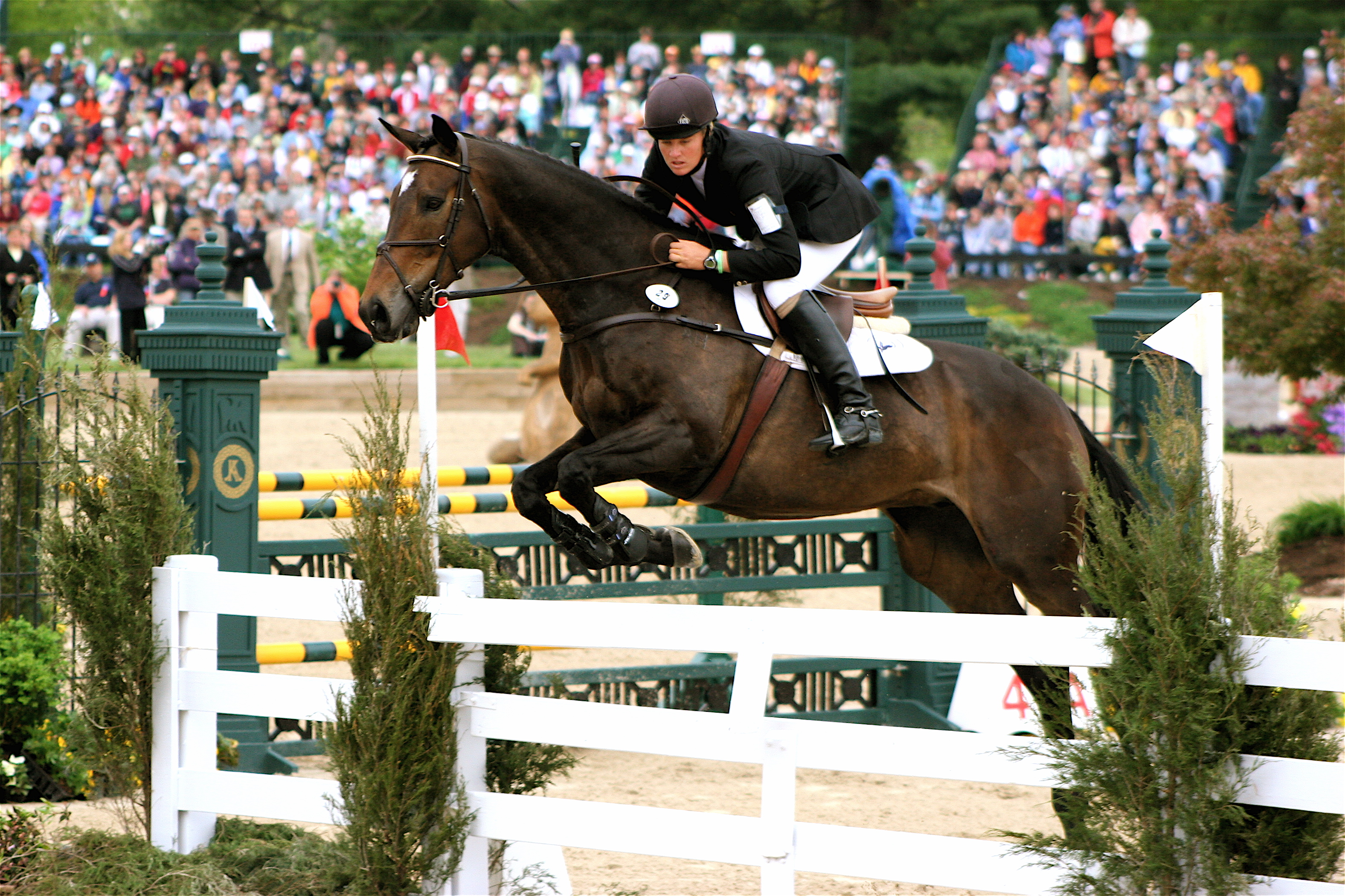
.jpg)
.jpg)
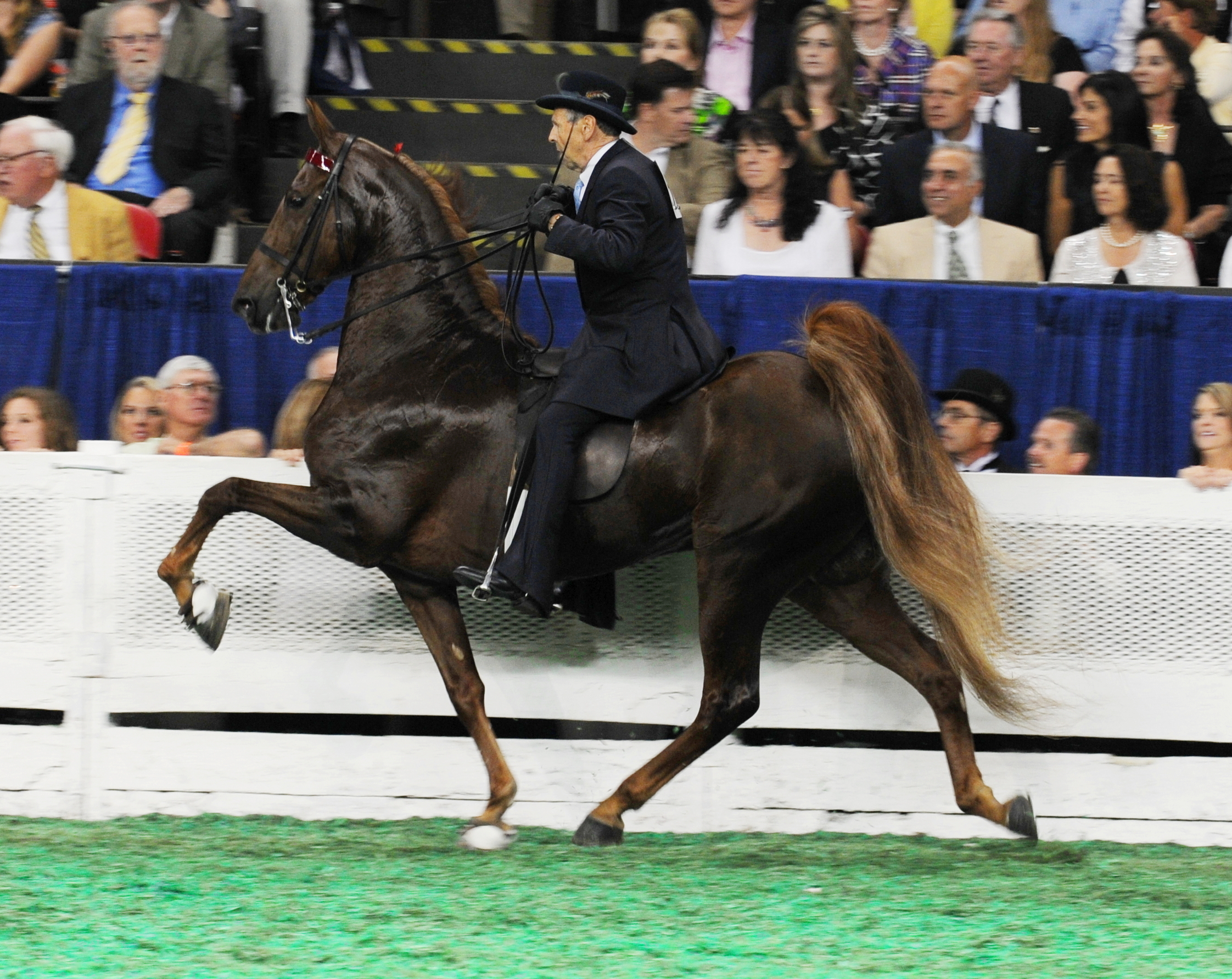
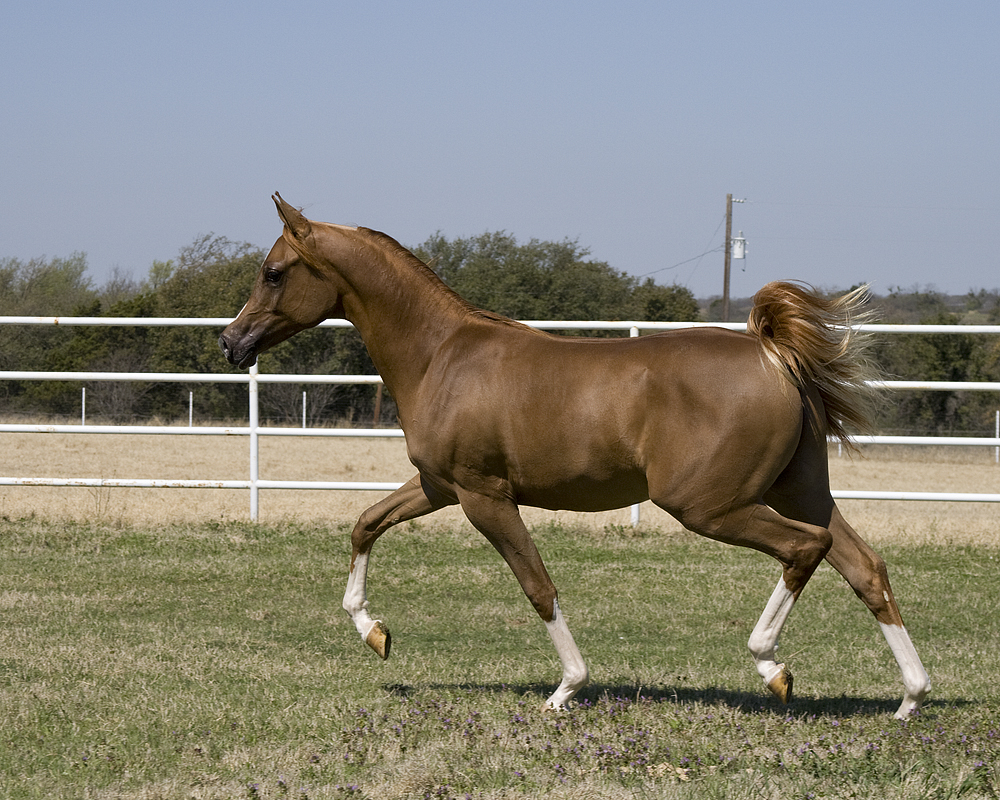
_(8536503249).jpg)
